Insuring that the intake and exhaust valves are closed in each cylinder before working on that cylinder requires turning the engine over by hand. I assume anyone doing major work on an in vehicle engine knows enough to disconnect the battery and the fuel before crawling around under the hood. If you don’t maybe someone else should be working on your ride.
As I mentioned in an earlier post it is critical the intake and exhaust valves are closed before any work is done on the spark plug wells.
When the valves are open on the Triton 6.8L V10 the edges of the valves intersect the line of the spark plug wells.
The Timesert reamer, tap, and setter fill the spark plug well and could chip, break, or bend a valve if the tool was inserted into a spark plug and struck an open valve.
Any damage to a valve means removing the heads and replacing the valve. A simple over the fender thread job gone horribly wrong.
Reaming and tapping generates abundant chips. Even using grease in the flutes to catch as many chips as possible I still ended up with chips down in the cylinder.
Aluminum cuttings inside of the cylinder.
You want to get the chips out of the cylinder before running the engine. If you blow the chips out with pressurized air, which works pretty well, you don’t want to get chips up into the intake where they will just be sucked back into the cylinder the first time you start the engine.
The bottom line is you want to get the valves closed before doing any work on that cylinder.
To confirm that the valves are closed Timesert recommends taking the valve covers off and checking that the rockers are not pressing the valves open. That sounds like work and mess I don’t want if it can be avoided.
While I wasn’t a fan of the Calvan kit for placing the inserts, see my previous post, Calvan does have a pretty slick way of determining if the valves are closed. With the valves closed the cylinder should hold compression, it should be “mostly” air tight. If the cylinder holds pressure the valves are closed. If either valve is open, intake or exhaust, the cylinder will not hold pressure. The Calvan kit comes with a trick little piece of hardware, which luckily can be purchased separately, that allows you to check that the cylinder is air tight through the spark plug hole.
With the spark plug removed you jam the rubber plug into the spark plug well creating a pretty much air tight seal between the rubber stopper and the well. Next close the small petcock on the other end of the tool and hook up a compressor to the compressor nipple. Slowly open the petcock and begin pressurizing the cylinder. If the valves are open, even a little bit, you can hear air escaping from the cylinder and the rubber stopper will remain seated. If the valves are fully closed the cylinder will pressure up and blow the rubber stopper out of the spark plug well.
The steps to check that the valves are closed are:
1. Hook up an air compressor to the tool
2. Jam the stopper into the spark plug well
3. Open the petcock and listen for air escaping from the cylinder
4. Slowly turn the engine over by hand using an 18 mm socket on the front of the crankshaft
5. Keep turning the engine until the valves close causing the cylinder to pressurize and blow the rubber stopper out of the spark plug well.
After all of that to make sure the valves are closed you need to make sure the piston is down. The piston rises up far enough in the cylinder for the insert tools to impact the top of the piston. After insuring the valves are closed I use a bamboo skewer through the spark plug hole to measure the depth to the piston and make sure there is plenty of clearance between the head and the piston.
To see some video of the Calvan tool in action check out these videos



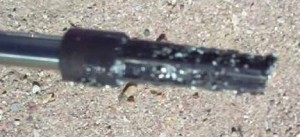
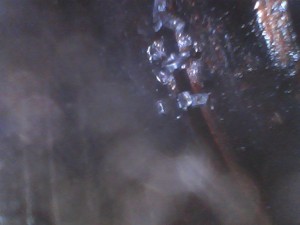
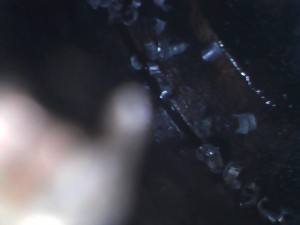

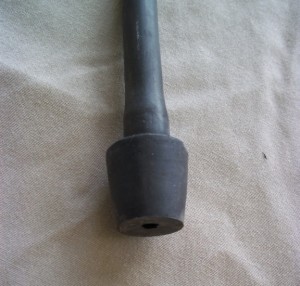
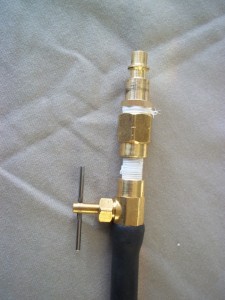
I’m about to try the Timesert repair on my 2000 Ford F-250 V10. The #4 spark plug on the passenger blew out. Since I you have done the repair could you shed a little light on what is in store for me? The cylinder in question seems a bit tight. Thanks Dave
Hey Dave,
It’s actually not as bad as I was afraid it might be. I ended up doing all 10 cylinders. With practice comes skill, meaning the 10th cylinder went fast, smooth, and easy, but the first cylinder, not as fast, smooth, or easy. Since you are only doing 1 cylinder you get all the pain and none of the practice.
First things first, make sure you clear off all the junk on top of the engine that’s in your way. You don’t want to be fighting hoses and cables and stuff while you’re trying to work.
Second, you’ll need an air compressor. You need to be able to blow the crud and chips out of the plug hole and cylinder and you’ll need the compressor for the air ratchet. You will need a 3/8 right angle air ratchet. I tried cutting (reaming) the first cylinder by hand and it was a non starter. I guess it could eventually be done but it was not easy cutting, and I sure wasn’t going to do 10 cylinders that way. You only need the air ratchet for reaming, all of the other operations will be by hand only, particularly the tapping and seating. Maybe you can get by with doing one cylinder by hand but it won’t be easy going.
Third, you want a shop vac and maybe 3 feet of 1/2 inch or so vinyl tubing. I used the compressor to blow most of the chips out of the cylinder after the tapping but it did not get all of them. You’ll want to use the shop vac / tubing to suck out all of the chips. I wrapped a rag around the tubing and stuck it in the end of my shop vac hose and it worked great.
Fourth, use lots of grease when reaming and tapping. Most of the chips will get stuck in the grease and come out with the reamer and tap. Make multiple passes when reaming and tapping, meaning cut a little, pull the tool out, clean off the chips, add some grease, and go a little deeper. This will really minimize the number of chips falling into the cylinder.
Fifth, wrap a rag around a 12 inch 3/8 extension and spray it down with carb cleaner to swab out the hole after the tapping operation. Get as much of the grease and chips cleaned out before putting in the insert.
Sixth, clean out the cylinder, compressed air and shop vac, before putting in the insert. The hole is much bigger before the insert goes in so you have more room to work.
Seventh, go slow. If something feels wonky, it probably is. Back off and look things over, make sure everything is lined up and going smoothly. Take your time and it turns out to be not such a big deal.
I’ve got a few thousand miles on my inserts and everything is ticking along great.